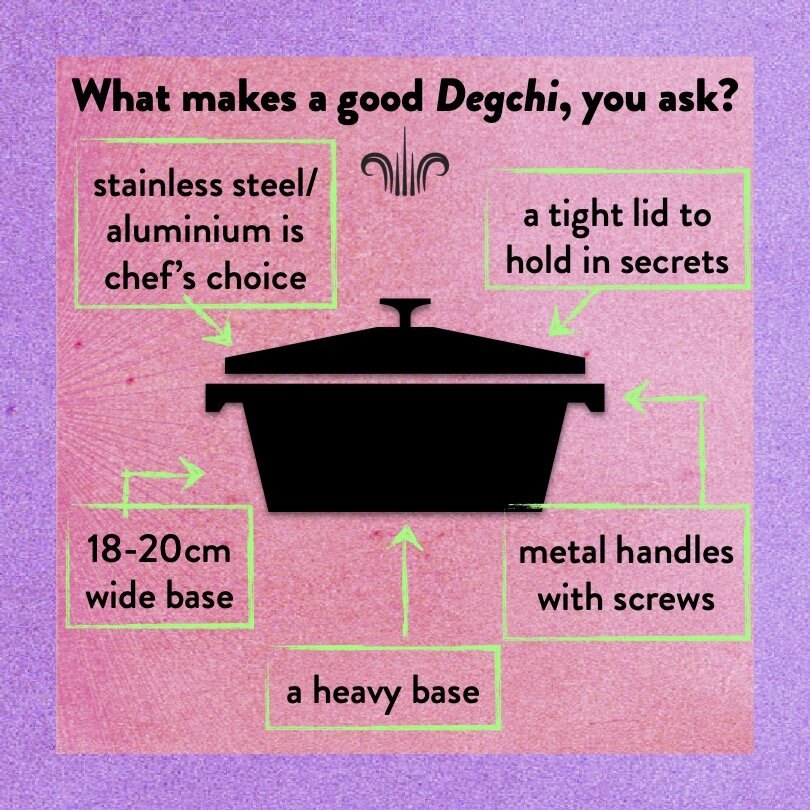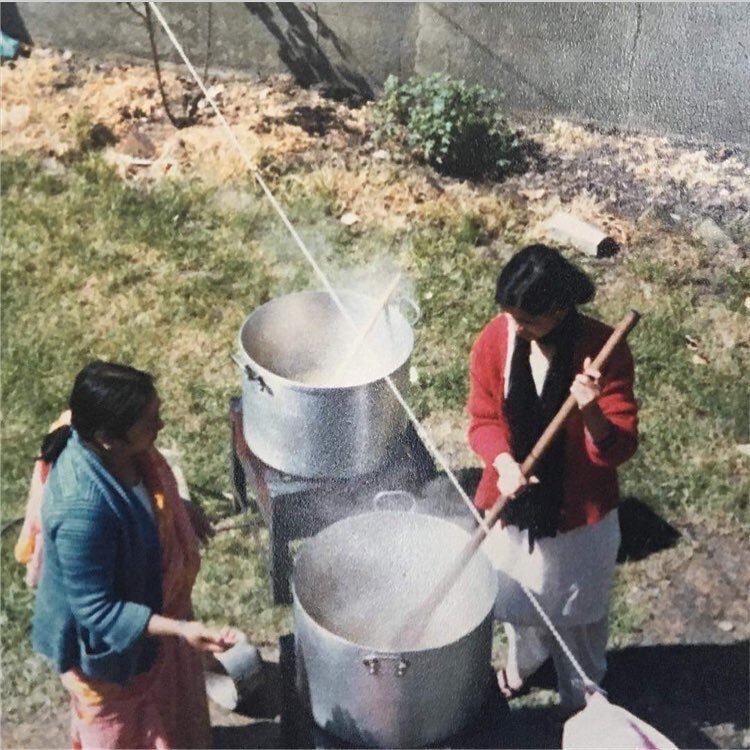Pakistani Kitchen Starter Pack
The desi mum
Let me introduce to the real Pakistani culinary master, my mum, Salma.
My mum features very regularly in my kitchen and in Parcha. I am imparting her wisdom to you. Just as she was taught by her mum. This is the Pakistani woman’s birthright, our wealth of inheritance.
The ONE Knife
Most Important
My Leith’s culinary training has certainly groomed a love for my chef’s knife and accompanying colour coded chopping boards. However, it is the mighty ‘all purpose’ paring knife that finds pride of place in desi kitchens.
Returning from work, my mum would cook the evening dinner, her hands hovering over the cooking pot already on the flame, preparing the vegetables with impressive dexterity. ‘Using a chopping board only adds to the washing at the end’ she says.
A ‘good' cooking pot
or Achi Degchi as it is known in Urdu
Bang clang, I always reach for my ‘good’ cooking pot. I’d probably run back into a burning building to save this worn and battered steel degchi.
What makes a good degchi you ask? A heavy base for slow cooking to avoid catching on the bottom. A wide base is also advised, for even distribution of heat.
I suggest visiting the convenience stores of Tooting and Brixton where similar cooking pots can be found piled high in various sizes.
The significance of a good cooking pot is most evident when boiling rice. Nothing is simpler and nothing more essential. Trust me.
We all have that auntie who loves to criticise everything we do. Think she’s not talking about your rice behind your back - think again!
Namak Mirch Haldi
Salt, Chilli Powder, Turmeric
I call this the holy trinity. The absence of chilli's tingling heat and the earthy warmth of turmeric can warrant a meal unseasoned in a Pakistani household. In fact if you don’t have them in your store cupboard, are you even brown?
Note of caution: Use turmeric with control, too much and it can overpower a dish. As little as half a teaspoon is often enough!
Pyaaz Lassan Adrak
Onion, Garlic, Ginger and chalo, let’s throw in some tomatoes!
So these may not necessarily be essential in every Pakistani dish but it’s reassuring to know you have them in your store cupboard.
The combination, quantities and place in the order of cooking can vary depending on what you’re making.
An increased amount of ginger in fibrous vegetables like cauliflower aid in the digestion, for instance. Finishing daal with caramelised onions lifts the soul of this humble dish.
And finally Chai
If you haven’t seen it already, head to my Instagram highlights to follow my technique to brew the perfect cup of chai.
It needs patience and care. It takes one hour. My mum was not impressed.
‘Who has time to brew chai for an hour’ she says.
And she makes a good point. My mum highlights a vital fact of Pakistani cooking at home - who has the time to spend an hour making a cup of tea! This is a rhetorical question - the fact is, no one does! The average home cook juggles quite a few things: work, cleaning that house, family and all that. There’s a lot going on. Reserve slow cooking for feasting dishes and batch cooking on Sundays.
I’m going to teach you how to make everything the old school way, taking my time, without any shortcuts BUT I will also share my mum’s tips and tricks along the way. She will make your life easier.
And while we’re on the topic of chai, I think it’s also important to share the picture of Arshad Khan, the chaiwala that went viral in 2016 (thank you @jiah_ali for sharing this fitty with us 😍)
After a short foray in acting and modelling, Arshad opened a cafe in Islamabad called Chaiwala. Go check him out if you’re in the area!
What are the essential spoons in the kitchen?
(I’m talking about the chamcha you use to cook and serve food. Not the spoon us desis shove rice in our mouths with)
The Wooden Spoon - Doi. This is a kitchen staple, your go to utensil for stirring everything. A well used doi is discoloured from use, maybe even charred from being left too close to the flame when cooking. A good doi is not round; neither is it squared off at the edge. It has a gentle curve, cut at an angle to sweep the base of the cooking pan efficiently. The nifty wooden spoon is used to make scrambled eggs, sweat onions and make a classic roux without lumps.
Moti doi - ah the memories of my mum shouting for the moti doi when one of us had been naughty! The moti doi, the thick wooden spoon in the kitchen, is used for the slow cooking and ghauttofying meat and daal. That is, pulverising the food through slow cooking, regular stirring and pressing it against the edge and base of the pot.
Methe ki doi - this is the classic wooden spoon, maybe smaller in size, exclusively used for making desserts. If you use the same regular doi for puds, the masala of everyday cooking that’s permeated the wood will ‘add’ to the flavour. I don’t want haldi in my halwa.
Silicone spatula, better yet, spoonula - There’s levels to this shi*, part spoon, part spatula, it gets into all the grooves, cleans the bowl and patella perfectly and doesn’t melt. It’s magic.
Metal Chamcha - This is the big boy big spoon at 2.5 tablespoons worth of measure. The slightly pointed tip is perfect for drizzling sauces, it’s hardy to stir the thick stews, cuts through your rice without breaking grains and can also be used for serving. Apparently this sized metal spoon is called a Kunz after the Manhattan restauranteur Gray Kunz.
Other spoons, (liquid food related) include the spork for noodly stuff, the ladle for decanting soupy stews and the slotted spoon for straining a solid out of liquid.
Teaspoons are for tea only, desis do not use them for cooking.
Click on the Kitchen Vibes image to listen to the tunes to play when you cook Empress Market Recipes!









